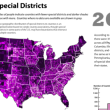Oh, the times are a-changing: A comprehensive look at some of the government trends of the future
The expression “there is no constant, except for change” has been a truism for government and educational teams as ever-changing challenges have been thrust upon them in an unprecedented manner. Strategic organizations are seeking to become more adaptable to address future trends.
Cyber security is top priority
Data breach costs in the public sector are increasing and ransom payments, where data is “stolen” by hackers and money is demanded for its return, is on the rise. According to Sophos State of Ransomware 2022 report, state and local governments average payments of $214,000 per incident. In many cases, ransomed data has been sold for nefarious reasons. When further sales cannot be made, the data is then ransomed back to the originating agency. However, paying the ransom does not guarantee the data will be returned.
According to the Center for Digital Government, in 2022, 92 percent of cities, 90 percent of counties and 64 percent of states carry cyber insurance. However, insurance only covers an entity AFTER a breach has been discovered. To be more proactive, the non-profit StateRAMP was created for a standardized approach to cybersecurity standards for service providers offering solutions to state and local governments.
Unauthorized access to government systems often occurs through third-party software that might not be thoroughly vetted for security measures. For instance, an invoice payment system for suppliers or survey software measuring customer service are ways that major breaches have occurred in the past couple of years, affecting millions of people.
Based off a successful model used at the federal level, Rebecca Kee, StateRAMP Government Implementations, states: “Local governments need an independent resource to vet and certify hundreds of suppliers who offer software and cloud-based solutions. No local entity has the resources or time to complete a deep-dive analysis for every product acquired. Instead, they usually rely on the vendor to self-certify or answer a checklist of capabilities—without any independent verification. Our philosophy is trust, but still verify.”
Through a StateRAMP free membership, a government member planning a purchase of software or cloud services, can now require that the supplier be verified by StateRAMP. With a nominal charge to the supplier, a verification model and vetting process ensures that more than 170 specific security points must be achieved and maintained to receive an annual credential.
While the process can be lengthy—up to six months—it is extremely thorough. A contract award can still be made and then the verification process negotiated to be conducted within the first year of the contract. Once verified, the supplier can then show this verification to other government clients to establish security credentials. Over time, StateRAMP strives to be the standard for security among government clients.
Workforce augmentation
As the Baby Boomer generation retires in greater numbers, the need for succession planning and backfilling empty positions is a huge challenge. The problem is further exacerbated by the difficulty to attract new employees. Many are not applying for long-term government careers, particularly as life-time pensions and health care are no longer guaranteed benefits.
Strategic Government Resources (SGR) is an organization that helps state and local municipalities be successful in recruiting, assessing, and developing government leaders. With the second largest local government job board in the nation, SGR serves more than 700 local governments in 47 states with special projects and attracting new talent.
Ron Holifield, the CEO of SGR, served two decades in city management within Texas, including assistant city manager in Plano; city manager in Garland, DeSoto, Farmersville and Sundown; and city manager’s staff in Lubbock. “There is a growing need to fill positions at all levels of government and increasing demand for specialized skill sets,” Holifiled says. “In addition, generational values create a paradigm shift in attracting new employees. New candidates are questioning archaic ways of government business and looking for ways to drive purpose over function.”
Holifield shares an interesting story in how shifting the mindset of a hiring entity might provide new opportunities. For one township in Texas, the upcoming retirement of the long-serving human resources (HR) director made the city manager realize that hiring someone of the same caliber would exceed their budget in attracting new talent. Instead, a different solution was pursued. Working with SGR, they retained a retired HR professional for two to three days per week, while outsourcing supporting duties. The result? The township receives greater coverage and retains a high level of expertise for the HR function, while generating personnel savings.
Dustin Lanier, founder and principal consultant for Civic Initiatives, acknowledges, “We have heard from procurement shops that recruiting remains a challenge. However, retention is now eclipsing recruiting as an area of workforce impact.” Lanier indicates his company, comprised of former government procurement professionals, has experienced an increased demand for services, from zero requests two years ago to almost a third of its business today.
“Outsourcing campaigns of the past were blunt instruments pursuing a work displacement strategy that can generate negative responses from existing employees,” Lanier says. “Strategic initiatives would be put in place, usually by outsiders, and would disappear after the completed engagement. The new model is ‘Procurement as a Service’ to extend a procurement organization’s staff line forward. This approach does not displace staff, but rather works in tandem with existing team members to address workloads and offer specialized expertise that procurement struggles to address through a full-time staff resource strategy alone.”
Supply chain resiliency
According to Deloitte’s Government Trends 2022, supply chain resiliency continues to be a strong focus. As municipal warehouses were reduced over the last decade, and contracts relied on same or next day delivery from suppliers, the pandemic exposed the weaknesses of a contracted guaranteed delivery time, especially when products were not available.
While the federal government is making inroads with inter-continental agreements and offering subsidies to move manufacturing to the United States, local governments are making their own plans. In some cases, warehousing is making a comeback, especially with emergency supplies. Where leasing or purchasing a warehouse proves to be too expensive, some are partnering with suppliers who designate a portion of their own warehouse for a specific entity, particularly where purchasing volumes warrant the expense.
Supply chain manufacturing and shipping delays further exacerbate the situation. Many agencies are told that it might take months, or even years, to fill requests, especially for heavy equipment and vehicles. Jon Stodola, regional business manager from the Toro Company, offers the following advice for entities who are strategizing on these larger purchases: “Plan further ahead by placing orders well in advance of a typical seasonal purchase. Don’t wait for things to break. It may take months to find a replacement. Also, collaborate with trusted suppliers to understand any market trends they see for the road ahead.”
Increased use of cooperative procurement
One of the most common complaints about the public bid process is that is can be quite time-consuming—for both procurement and suppliers. Having a government or cooperative organization conduct that lengthy procurement process, resulting in a contract that leverages volume pricing advantages, has become a streamlined contracting method.
Jensen Mabe, vice president of sales and business development from the Interlocal Purchasing System (TIPS), shares the benefits of cooperative procurement for both sides of the procurement desk. For public agencies, he states, “Utilizing cooperative contracts allows procurement personnel to focus on managing their purchases, instead of the time-consuming bid process. On the supplier side, it focuses their efforts on offering best value solutions, rather than spending resources on responding to hundreds of individual solicitations. A recently awarded supplier shared that by adding a cooperative contract into their sales strategy allowed them to elevate their company’s public sector business over 200 percent year-to-year.”
As government needs are changing, so are the types of contract offerings. A newly formed TIPS partnership with CommercePayments Payment Hub manages vendor information and facilitates payments, while providing a reconciliation file back to an entity’s ERP system. The system simplifies and expedites the AP process—an end-to-end solution for receiving, approving, paying, reconciling and storing invoices. Serving as a help desk for supplier payment questions, a time-consuming process for resource strapped agencies, the best part of the value proposition provides a revenue sharing opportunity. To date, $9 million has gone back to its 400+ education and government clients.
Mabe offers a glimpse of continuing evolutionary changes. “While energy savings performance contracts have historically been a part of cooperative contract portfolios, there is a recent shift in Energy Efficiency as a Service (EEaaS), allowing facility upgrades without the burden of raising capital or relying on bond elections,” he says. “Construction and job order contracts also appear to be on the rise, especially for quickly needed repair projects. Facility directors are realizing the value of a contracted construction team that can be quickly mobilized.”
Urgency for sustainability
As climate change increasingly affects communities, with regional emergencies such as intensified hurricanes and wildfires, the focus on healthy environments is gaining political attention. Municipalities are responding to address the issue and reduce their own carbon footprint.
In Minnesota, St. Paul and Minneapolis unveiled their first five electric carsharing hubs in the Twin Cities, for a joint 70-station Electronic Vehicle (EV) Spot network. The $12 million network is used to charge both private electric vehicles and new Evie Carshare vehicles from HOURCAR, a St. Paul-based nonprofit. HOURCAR members can reserve EV Spots curbside within a 35-square-mile service area, allowing access to electric cars that some might not be able to afford on their own.
The 70 EV Spot charging locations doubles the number of public charging ports in the Twin Cities and considered the nation’s largest publicly owned electric vehicle initiative. Winner of the 2018 Bloomberg Philanthropies American Cities Climate Challenge, this project aims to curb greenhouse gas emissions, particularly related to the largest users of non-renewable energy—transportation and buildings.
With an expensive initial price tag for the project, a strategic partnership was needed with a funding source with expertise in municipal funding and fleet leasing. NCL Government Capital provided multiple solutions for this complex project, including the use of federal tax credits to help offset a portion of the vehicle costs. The various leasing solutions gave the project the ability to access more vehicles than they originally envisioned within the same budget.
Partnering for innovation
With shrinking resources, compounded with the desire to be innovative, many entities are relying on supplier networks and experts in industry to assist on new projects. As a former parks and ground administrator, and now assistant to the city manager for Greenville, S.C., Megan Young shares her experience with a major solar project.
With this forward-thinking concept, in-house expertise to answer basic questions of how to proceed, who will do the work and how to quantify success did not exist. Rather than attempt to issue a bid and hope for the best, they decided to interview industry expert suppliers and contract through a cooperative contract. RoofConnect was brought onboard for their consulting expertise. “Using an already awarded contract allowed the opportunity for a partnership rather than a transactional relationship,” Young says. “Together, our teams performed a walk-through of the facilities, identified the strengths and weaknesses of various options, with open and transparent conversations on what would work best.”
For the David Hellams Community Center, the city initially envisioned installing solar panels on the recreation center roof. However, through discussions with RoofConnect, they determined the better option was a nearby covered basketball court roof and scheduled installation around recreation schedules. Young states, “Having a relationship with our chosen supplier made the process much smoother.”
From RoofConnect’s perspective, Ken Beck, director of business development states, “We appreciate the opportunity to share our expertise and knowledge. The traditional bid process does not always allow for these types of conversations and collaboration, as we are just as invested in a project’s success.”
Supplemented by a $10,000 mini-grant from the South Carolina Department of Energy, 100 solar panels were installed last July. To embrace local support and further educational efforts, an open house was scheduled for the community. “We scheduled the event when parents were arriving during the afternoon shift to collect their children,” Young says. “Sharing information about the project and resulting energy savings, allowed us to introduce the concept of solar energy to both students and parents. As of October 2022, we saved over 94.68 lbs. of carbon dioxide, which is equivalent to planting over 715 trees.”
Keeping government accessible
Good communication is a crucial part of providing government services to the public, particularly in high consequent areas such as 911 emergency calls. Think of the last time you were called for jury duty, had to navigate a new DMV system or required legal representation. These situations can be confusing. Now, imagine if you were one of the millions of people who is not proficient in English, or has a hearing or visual impairment. Critical information might be misinterpreted, or missed completely, along the way.
Ed Regan, director of sales for GLOBO, a company dedicated to language access, shares, “an estimated 61.6 million people—born both inside and outside the U.S.—speak a language other than English at home. The limited-English proficient (LEP) population has grown rapidly in recent years, increasing more than 80 percent between 1990 and 2013 from 14 million to 25.1 million.
GLOBO has been the city of Philadelphia’s comprehensive language support partner since 2017. As the city transformed during the Covid-19 pandemic, GLOBO supported the city’s Department of Health by transitioning to fully remote home visits and meetings that required interpreters via GLOBO’s Multi-participant Video Remote Interpreting solution; assisted the daily COVID press briefings where information was shared on city policies, testing sites, school closures and other government mandates; and implemented new dedicated telephone lines for departments like the Office of Emergency Management and the city’s COVID Contact Tracing Unit. Last year alone, GLOBO serviced more than 350 different languages.
With a belief that everyone should have equal access to information, GLOBO calls for a more “empathetic future.” “The need for better experiences will no longer be a nice-to-have, but a necessity,” Regan says. “To provide impactful services that move the needle, government teams must consider the journey that all their residents take when accessing resources and services.”
Tammy Rimes, MPA, is the executive director of the National Cooperative Procurement Partners (NCPP). She formally served as purchasing agent for the city of San Diego, the ninth largest city in the nation, and emergency logistics chief during the 2007 Witch Creek Fires. Under her leadership, the city consolidated its warehouse operations, centralized all purchasing and contracting operations, and moved to a more customer focused approach.
Editor’s Note: This article originally appeared in the Fourth Quarter issue of Government Procurement.




















